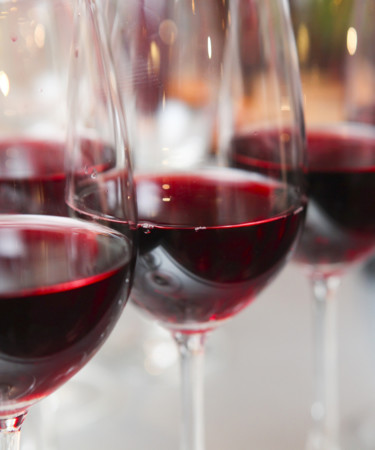We have all been beginners in wine at some point, and whether you’ve decided you’d like to get into red as a newbie, or you’ve been drinking one specific red for years and now want to branch out, in order to figure out what you like, it’s important to grasp an overview of the different styles that are out there. But it isn’t likely that many of us will be able to taste the insane amount of options available, so we need to start with wines that give us a good representation of the wide spectrum of what’s available.
Don’t worry, we’ve done the hard work for you. All you need to do is head to your local wine shop and ask for a good representation of the four wines below. Take them home and pop all of them in the same night, tasting through the bottles in the order they’re discussed below. These wines will take you on a journey to help you understand acidity, tannin, body, and alcohol and in the end, help you figure out how to talk about the red wine styles you like and the ones you don’t.
Pinot Noir
The first step is to understand how to taste acidity, and Pinot Noir is the perfect wine to help you do that. Pinot has a cult following among wine geeks because the flavors and aromas can be quite surprising, all of the elements just works together so well. The wine is a very light red color in the glass, and has the lightest body of all the wines you’ll taste. When you smell the wine, you’ll often get aromas of cherries, raspberries and cranberries. Pinot has very low tannins, so the acidity – think the pucker you get from lemonade – will really shine through. We prefer Pinot Noirs made in the Old World style because they show the lean structure and bright acidity best. While New World Pinots are also great, they can often be “riper,” causing them to have a juicier flavor that can often taste jammy, muting some of the acidity you want to experience.
If you find you loved the acidity, wines with similar flavor profiles include Gamay, Grenache/Garnacha, Nebbiolo, and Etna Roso.
Syrah
Time to understand body, and there is no better wine to start this journey than Syrah. This is that big, inky red wine with flavors of dark fruit, such as plums and blueberries, with a little chocolate and tobacco thrown in for good measure. If you’re looking for a velvety, smooth wine, this is the one for you. It’s the perfect wine with lamb, and would welcome an invitation to any cheese party you might be having.
If you like Syrah, your next go-to wine should be Rhone blends from France. Malbec is also a wine you’ll probably enjoy.
Cabernet Sauvignon
Now it’s time to get a grasp on whether or not you like tannins. Tannins are what makes your mouth feel a bit dry as you swallow, and they’re fantastic antioxidants. Cabernet Sauvignon is a great wine for experiencing these tannins, not to mention that it’s the most popular red wine in the world, so as a beginner it’s important to understand whether or not you like it. The wine is full bodied with aromas of dark cherries, spice and hints of vanilla, as the wine is often aged in oak. When you sip it, you’ll pick up some green pepper notes that also give the wine a nice herbaceous quality. It’s the ideal steak wine, and is much better when drunk along with food.
If you enjoy Cabernet, other wines to try are Merlot, Sangiovese (Chianti), Tempranillo (Rioja), and the classic Bordeaux blend. If you loved the green pepper notes, you’ll also be particularly fond of Carménère and Cab Franc.
Zinfandel
It’s time to grasp the impact alcohol can have on a wine. Yes, every wine has alcohol inside it – we probably wouldn’t love it as much if it didn’t – but some have a higher booze content than others, and Zinfandel is one of those wines. With Zinfandel, an overwhelming flavor and aroma you’re going to get is jam and that’s because the fruit is often very ripe when it’s picked. It’s this ripeness that results in the wine’s alcohol being high. This is also why “Old Vine” Zin is prized above regular Zin. As a vine ages, it produces less fruit, but that fruit is richer and more flavorful than in the vine’s youth, which results in a richer wine. High alcohol causes a wine to taste “bold,” or feel “big” to us. This is why Cabernets from California can often taste much bigger and richer than Cabernets from France, because the alcohol is usually much higher.
If you like Zinfandel, you’re a fan of rich, New World wines from hot climates.
